From Esther's bravery to prophetic visions, uncover the intriguing role of ancient Persia in the Bible and its lasting spiritual legacy.
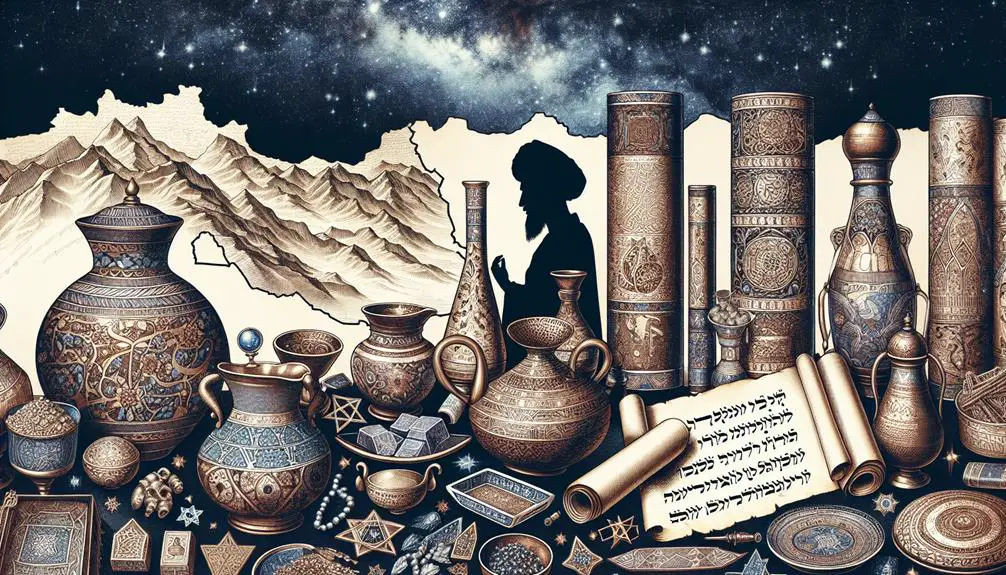
Who Is Iran in the Bible
Navigating the historical landscape of Iran in the Bible is like embarking on a treasure hunt, where each clue leads you closer to understanding a complex and rich past. You'll discover that ancient Iran, known as Persia, plays a pivotal role in biblical history, from providing the backdrop to the captivating story of Esther to being the empire that allowed the Jewish exiles to return home.
As you explore the connections between Iran and key biblical figures, along with its mention in prophetic visions, you're left wondering how this ancient civilization's spiritual legacy continues to influence the modern world.
Key Takeaways
- Iran, historically known as Persia, played a significant role in biblical events and prophecies.
- Cyrus the Great, a Persian ruler, is celebrated for allowing Jewish exiles to return and rebuild the Temple in Jerusalem.
- The Persian Empire's policies of religious tolerance influenced the diverse spiritual landscape of the biblical era.
- Ancient Persia's contributions to governance, culture, and religious thought are reflected in biblical narratives and interpretations.
Ancient Name of Iran
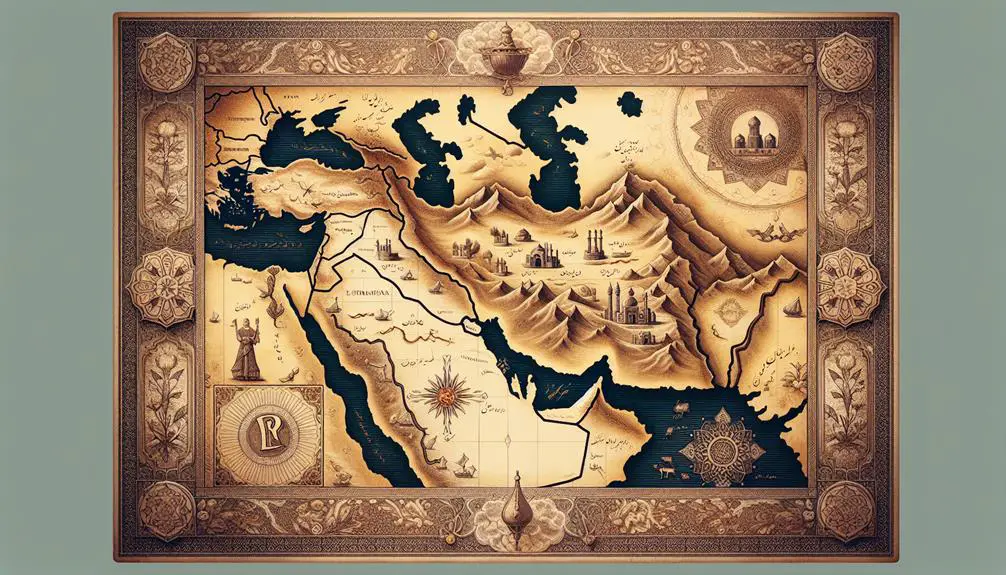
In ancient texts, Iran is frequently referred to as Persia, a name that resonates with a rich tapestry of cultural and historical significance. This reference isn't merely a matter of semantics but a nod to the deep-rooted civilizations that have shaped the region's identity over millennia. You'll find that the story of Iran, or Persia, isn't linear but a complex interweaving of cultures, notably marked by Elamite origins and Median integration.
The Elamites, one of the earliest civilizations in what's now southwestern Iran, laid the groundwork for the sophisticated society that Persia would become. Their contributions aren't just footnotes in history; they're pivotal chapters in the narrative of the region's development. The Elamites were known for their advances in writing, architecture, and governance, setting a precedent for the civilizations that followed.
As you delve deeper, you'll encounter the Medes, an Iranian people integral to the region's history. The Median integration into what would become the Persian identity wasn't merely a conquest or a simple merging of territories. It was a synthesis of cultures, beliefs, and governance models that enriched the tapestry of the region. This integration played a crucial role in shaping the administrative and cultural frameworks of the empire that would emerge.
Understanding the Elamite origins and Median integration is essential to grasp the full spectrum of Iran's historical and cultural landscape. It's a narrative that goes beyond conquests and dynastic changes, highlighting the region's capacity for cultural synthesis and innovation.
The Persian Empire
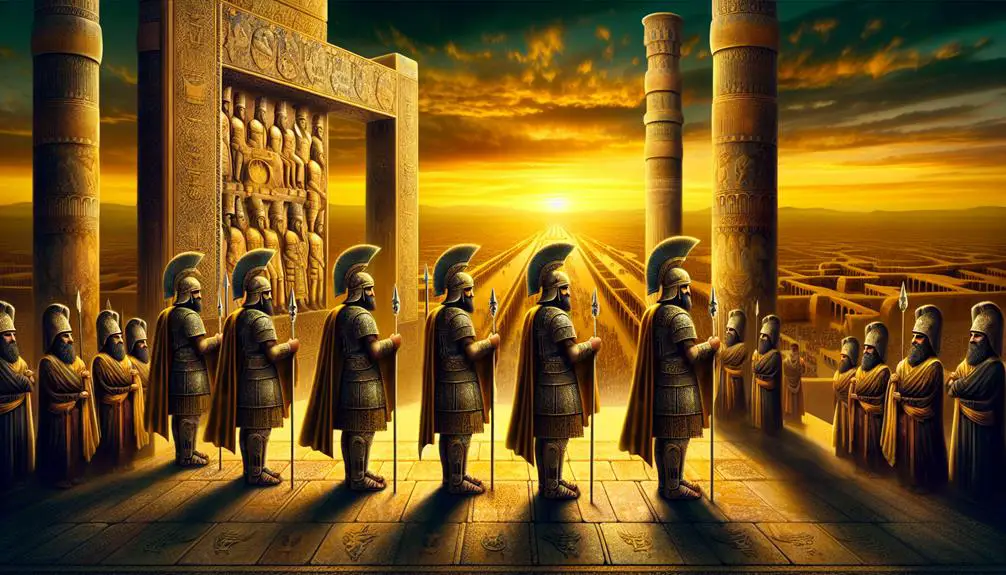
As you explore the Persian Empire's narrative, you encounter its dramatic ascent under Cyrus the Great, a pivotal figure whose policies reshaped the ancient Near East. His conquests laid the foundations for a vast empire that significantly influenced Israel, marking a profound chapter in biblical history.
This segment will analyze the rise of Persia, Cyrus's unique leadership, and the empire's lasting impact on Israel, offering insights into their intertwined destinies.
Rise of Persia
Amidst the upheaval of ancient civilizations, the Persian Empire rose to prominence, reshaping the political landscape of its time. It wasn't just about military conquests; you'll find the underpinnings of this empire's strength lay in its innovative approaches to governance and society. The Zoroastrian influence, for instance, introduced concepts of morality and justice into the administrative and social frameworks. Additionally, the establishment and expansion of trade networks not only bolstered the economy but also facilitated cultural exchanges, enriching the Persian civilization further.
Aspect |
Details |
Impact |
|---|---|---|
Zoroastrianism |
Introduced ethical dualism |
Shaped moral and legal systems |
Trade Networks |
Expanded across Asia, Africa, and Europe |
Boosted economy and culture |
Administrative |
Implemented satrapies system |
Enhanced governance efficiency |
Cultural |
Promoted arts and architecture |
Fostered a rich cultural legacy |
Cyrus the Great
Building upon the foundations of innovative governance and cultural richness, Cyrus the Great emerged as a pivotal figure in the expansion and consolidation of the Persian Empire. His reign marked a period of significant achievements, laying the groundwork for what would become a lasting legacy. Cyrus's approach to leadership and governance introduced several Persian innovations that have been admired through the ages.
- Centralized Administration: Streamlining governance across diverse territories.
- Respect for Local Customs: Encouraging cultural diversity within the empire.
- Military Strategy: Utilizing innovative tactics to expand and protect the empire.
- Infrastructure Development: Fostering economic growth through road networks and postal systems.
Cyrus's legacy is a testament to his visionary leadership, blending Persian innovations with a respect for the cultures within his realm, setting a precedent for future rulers.
Impact on Israel
The Persian Empire's policies, particularly under Cyrus the Great, had a profound impact on Israel, reshaping its social, political, and religious landscape. His decree allowing Jewish exiles to return to Jerusalem and rebuild the Temple fostered a unique bond, shaping Israel's alliances and identity. This historical relationship echoes in modern conflicts, where alliances are pivotal.
Emotion |
Context |
|---|---|
Gratitude |
For Cyrus's decree allowing the return to Jerusalem. |
Resilience |
In rebuilding amidst ruins, solidifying a national identity. |
Anxiety |
Over modern conflicts, influenced by historical alliances. |
Hope |
For peace, inspired by past reconciliations between nations. |
Understanding this historical context provides insight into the complexities of Israel's current alliances and its stance in modern conflicts.
Key Biblical Figures
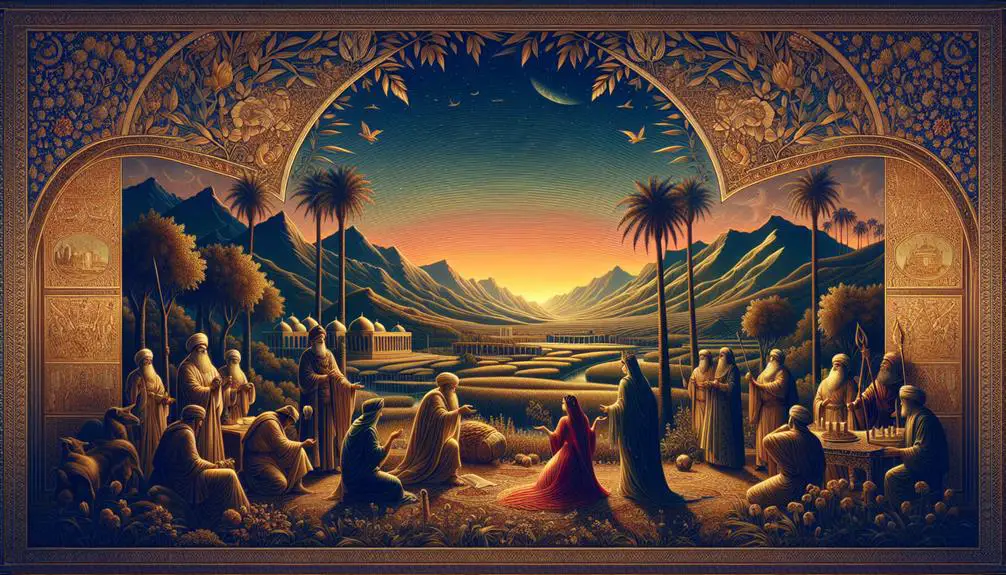
Exploring key biblical figures reveals their profound connections with ancient Iran, shedding light on pivotal moments and interactions within the scriptural narrative. These figures, through their journeys, wisdom, and leadership, intersect with the history and lands that are part of modern-day Iran, offering insight into the complex tapestry of biblical history.
- Abraham's Journey: Abraham's travels, crucial to understanding the formation of the Israelite people, intersect with regions that would later be part of the Persian Empire. His quest for a promised land sets the stage for future interactions between his descendants and Iran.
- Solomon's Wisdom: Known for his unparalleled wisdom, Solomon's reign exemplifies the exchange of goods and ideas between Israel and surrounding regions, including those under the sphere of future Persian influence. His diplomatic and trade relationships highlight the interconnectedness of the ancient Near East.
- Esther's Courage: As a Jewish queen in the Persian Empire, Esther's story is directly tied to Iran. Her bravery in saving her people from genocide underlines the significant influence that individuals from biblical narratives had within the Persian court.
- Cyrus the Great: Though not an Israelite, Cyrus's decree allowing the Jews to return to Jerusalem and rebuild the Temple marks him as a pivotal figure within the Bible. His actions demonstrate the positive relationships that could exist between the Jewish people and the rulers of ancient Iran.
These characters and their stories provide a nuanced understanding of the relationships between the biblical Israelites and the lands and peoples of ancient Iran, revealing a rich tapestry of interaction, influence, and mutual respect.
Prophetic Visions and Iran
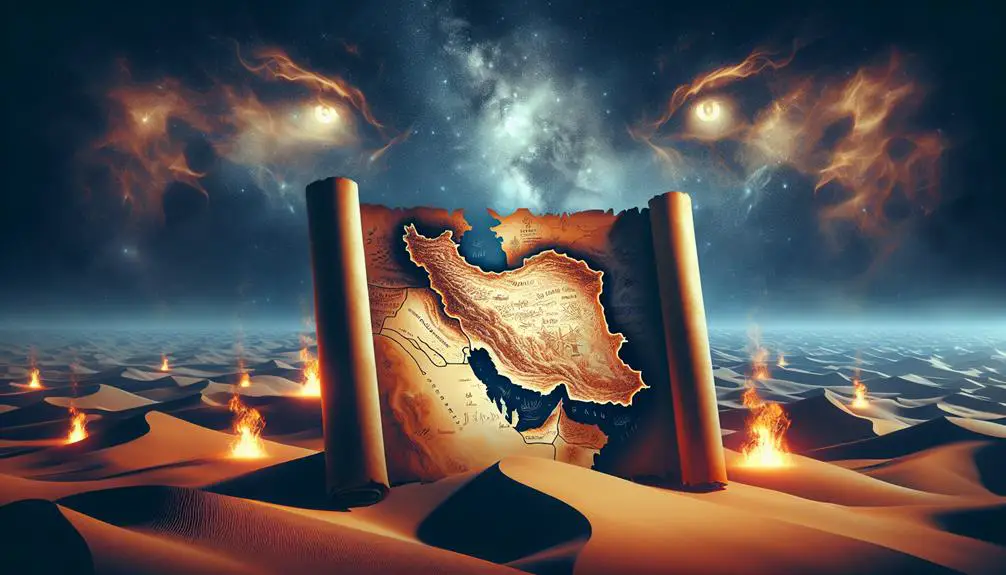
You'll find that Iran's historical roots, known in ancient times as Persia, play a crucial role in biblical prophecies.
The nation's depiction in end-time forecasts and its connection to pivotal moments in scriptural narratives highlight its significance.
Specifically, Daniel's vision, often interpreted within various theological frameworks, underscores Iran's enduring impact on biblical prophecy discussions.
Ancient Persia's Biblical Role
In biblical texts, Ancient Persia plays a pivotal role, often appearing in prophetic visions that underscore its significant impact on Israel's history and future. This era marked by:
- The rise of monotheism under Zoroastrian influence
- The implementation of Artaxerxes' reforms
- The rebuilding of the Jewish community
- The protection of Jewish rights across the empire
These elements reflect a unique relationship between Persia and the biblical narrative, showcasing a period where political and religious policies significantly influenced the development of Jewish religious identity.
The respect for diverse cultures and religions under Persian rule, especially during Artaxerxes' reign, set a precedent for tolerance and support that had far-reaching effects on the region's religious landscape, deeply embedding the Persian legacy within biblical history.
Iran's End-Time Prophecies
Delving into Iran's end-time prophecies reveals how its ancient narratives continue to cast a long shadow over modern interpretations of biblical prophecy. The geopolitical implications of these interpretations are significant, influencing how scholars and theologians view the region's role in the prophetic landscape.
Aspect |
Ancient Narratives |
Modern Interpretations |
|---|---|---|
Focus |
Prophetic Roles |
Geopolitical Implications |
Source |
Biblical Texts |
Contemporary Analysis |
Impact |
Theological |
Political & Social |
Scope |
Regional |
Global |
These prophecies, once rooted in ancient scripts, now intersect with today's geopolitical dynamics, challenging you to consider how historical perspectives shape our understanding of the future. This analytical journey through Iran's prophetic visions underscores the complexity of reconciling ancient texts with contemporary geopolitical realities.
Daniel's Vision Interpreted
Exploring the interpretation of Daniel's vision opens a new chapter in understanding Iran's place within biblical prophecy, highlighting the complexity of its ancient and modern roles. The Vision Symbolism and Modern Interpretations offer a nuanced view of Iran's portrayal in scriptural contexts.
- *Modern Interpretations* delve into how contemporary scholars view Iran's representation in prophecy, considering geopolitical shifts.
- *Vision Symbolism* uncovers the layers of meaning behind the symbolic imagery associated with Iran, offering insights into its prophetic significance.
The role of *historical context* in shaping the understanding of these visions, emphasizing the importance of considering the time when these prophecies were written.
The impact of *cultural interpretations* on how these visions are understood today, highlighting the diversity of perspectives on Iran's biblical role.
Iran's Biblical Lands
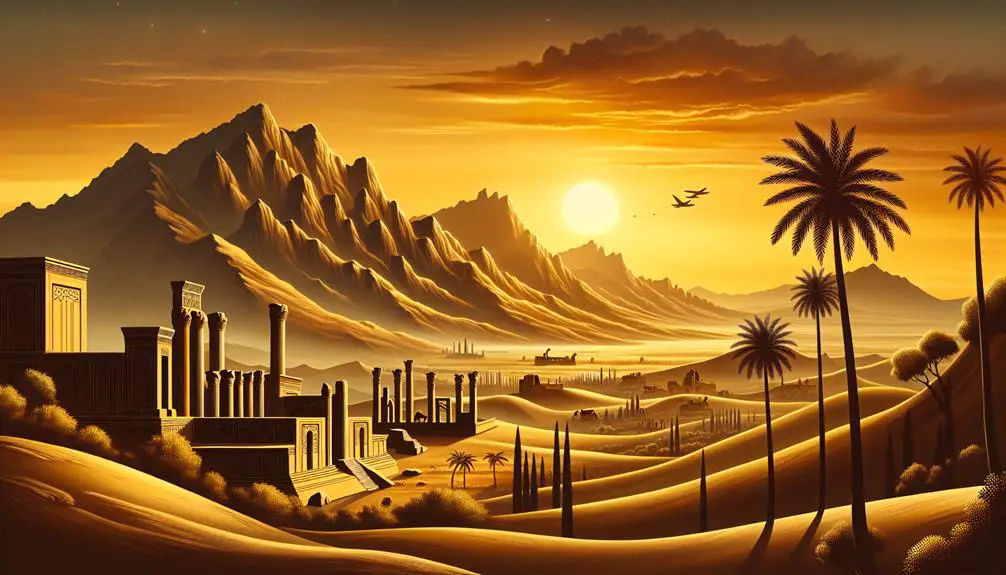
Iran's biblical lands, often referred to in ancient scriptures, play a pivotal role in the historical and spiritual narratives of the Bible. These territories, rich in history and culture, were home to ancient civilizations, such as the Elamite civilization and later saw the integration of the Median people. The Elamites, known for their advanced society and significant contribution to the development of writing, mathematics, and law, were centered in what's modern-day southwestern Iran. Their influence extended into biblical narratives, where Elam is mentioned in contexts that highlight its significance and interactions with other major powers of the time.
With the rise of the Medes, a notable shift occurred in the region. Median integration into the area brought about a new era that saw the merging of cultures and the establishment of a powerful kingdom that would play a crucial role in the geopolitical dynamics of the Middle East. This period is crucial for understanding the backdrop against which many biblical events unfolded, providing a historical context that enriches the biblical stories.
Analyzing Iran's biblical lands through the lens of the Elamite civilization and Median integration offers a unique perspective on the complexities of ancient Near Eastern history. It showcases how these lands weren't only significant in their own right but also integral to the broader narrative of the Bible. Understanding this context allows for a deeper appreciation of the historical and spiritual significance of these regions, illuminating their role in the biblical narrative beyond simple geographical references.
Major Biblical Events
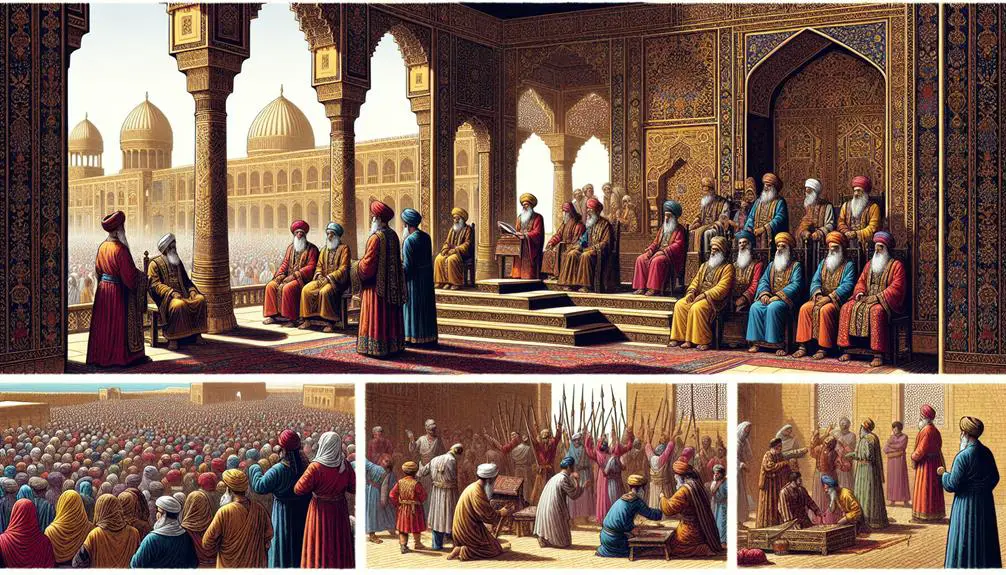
Turning our focus to major biblical events reveals how the lands that are now Iran played a pivotal role in shaping the narratives of the Bible. This area, rich in history and culture, intersects with several key biblical moments that have left an indelible mark on religious traditions and teachings. Through an analytical lens, let's delve into how Iran's ancient territories contributed to these foundational stories.
- The Tower of Babel: Located in the broader region that encompasses modern-day Iran, the story of the Tower of Babel highlights the diversification of languages and the dispersal of humanity across the earth. This narrative underlines the area's significance in biblical history as a crossroads of cultures and peoples.
- The Journey of Abraham: Abraham's passage through Mesopotamia, near the borders of what's today Iran, marks a crucial phase in biblical history. This journey underscores the region's role in the formation of the Abrahamic religions and the spread of monotheistic beliefs.
- The Adventures of Noah's Ark: Although the final resting place of Noah's Ark is debated, its journey through the great flood and its implications for humanity's redemption and covenant with God are central to biblical teachings. The surrounding regions, including parts of ancient Iran, form the backdrop to this epic narrative.
- The Construction of Solomon's Temple: While Solomon's Temple itself was located in Jerusalem, the materials and craftsmanship, influenced by neighboring regions including ancient Iran, underscore the interconnectedness of the ancient Near East. The temple's construction highlights the cross-cultural exchanges that enriched biblical events.
These events, among others, illustrate Iran's biblical lands' profound influence on the narratives that shape religious thought and tradition today.
The Book of Esther
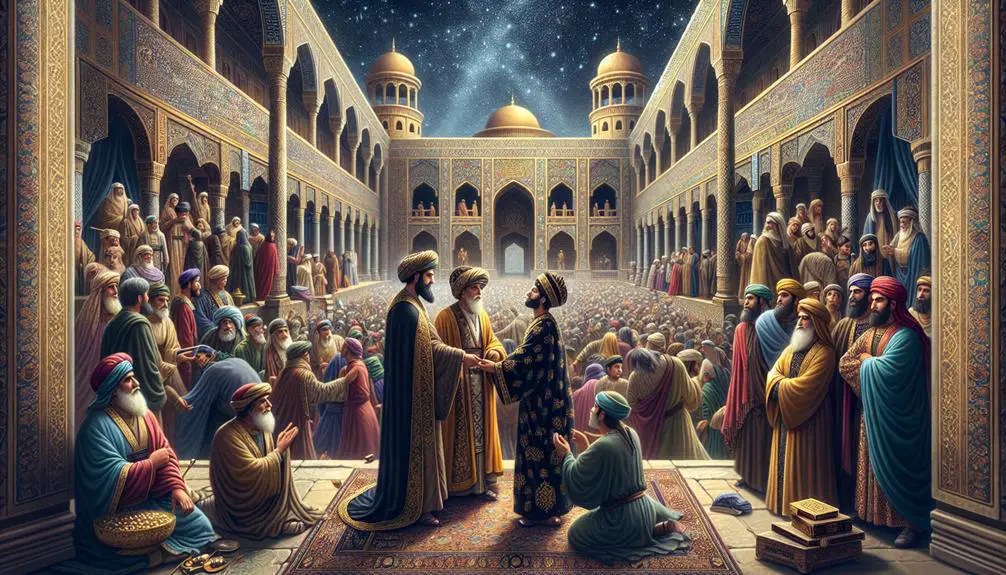
Building upon our understanding of Iran's biblical significance, the Book of Esther stands as a pivotal narrative, deeply rooted in the ancient lands that are now Iran. This book unveils a story of courage, faith, and divine intervention, set against the backdrop of the Persian Empire. It's a tale that not only highlights the historical presence of Jewish people in Iran but also underscores the complexity of their survival and resilience.
At the heart of this narrative, you encounter Mordecai, a Jewish man whose unwavering loyalty and wisdom play a crucial role in saving his people from annihilation. His actions, driven by faith and a profound sense of duty, underscore the themes of loyalty and divine providence that permeate the story. Mordecai's relationship with Esther, his cousin, whom he'd raised as his own daughter, is central to the unfolding of events that lead to the Jewish people's salvation.
The Book of Esther also gives rise to the Purim celebration, a joyous Jewish festival commemorating the deliverance of the Jewish people from their enemies. Purim's observance is deeply intertwined with the narrative of Esther and Mordecai, highlighting the triumph of good over evil and the importance of community solidarity. This celebration serves as a reminder of the enduring spirit and faith of the Jewish people, as well as the significant role that Iran—or ancient Persia—plays in their storied history.
Analyzing the Book of Esther, you gain insight into the intricate tapestry of faith, politics, and survival in ancient Iran, showcasing a period of history where divine intervention and human courage intersect to change the course of lives and nations.
Iran's Spiritual Legacy
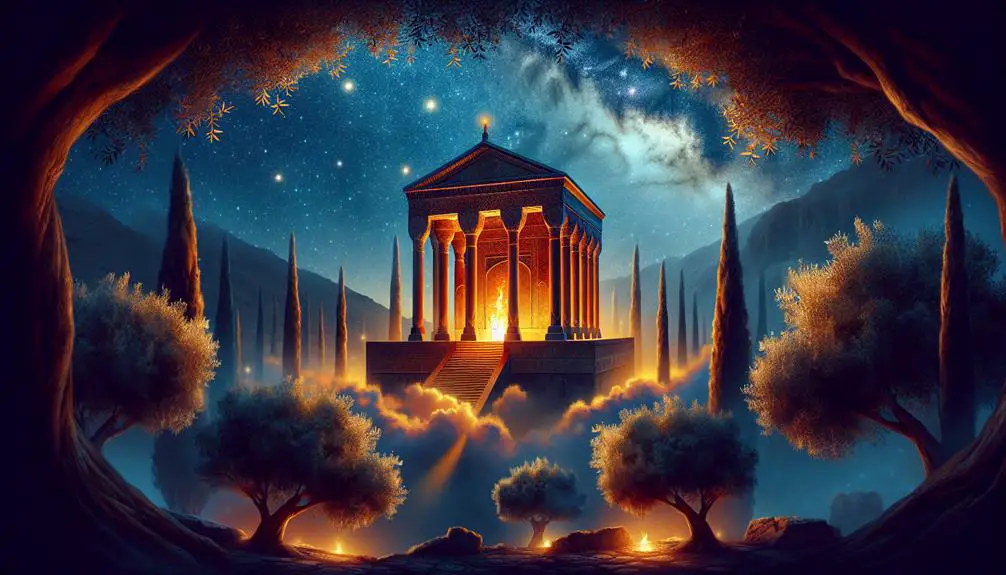
Delving into the spiritual legacy of Iran, one can't overlook its profound impact on religious thought and practice throughout history. At the heart of this legacy are the Zoroastrian influences that have permeated not only the region's spiritual landscape but also the broader spectrum of world religions. This ancient faith, predating Christianity and Islam, has contributed significantly to the concepts of dualism, the afterlife, and the struggle between good and evil that are evident in various religious traditions.
Iran's spiritual heritage is characterized by:
- Zoroastrian influences: The teachings of Zoroaster, emphasizing the battle between good and evil, have left an indelible mark on religious philosophy, particularly in the concepts of heaven, hell, and judgment day.
- Religious tolerance: Throughout its history, Iran has been a mosaic of religious beliefs and practices, showcasing a remarkable degree of tolerance towards different faiths.
- Cultural contributions: The Persian Empire's emphasis on learning and culture facilitated the preservation and transmission of religious texts and ideas across civilizations.
- Philosophical impact: Iranian thinkers and theologians have played a crucial role in shaping the theological and philosophical discourse of Islam and other religions.
This rich spiritual tapestry underscores Iran's pivotal role in the development of religious thought across millennia. The enduring legacy of Zoroastrianism, coupled with a historical commitment to religious tolerance, highlights Iran's unique contribution to the spiritual and philosophical heritage of humanity.
Frequently Asked Questions
How Has Modern Archaeology Influenced Our Understanding of Iran's Role in Biblical History?
Modern archaeology has deeply enriched your understanding of Iran's historical significance. With advanced excavation methodologies and a focus on artifact preservation, archaeologists have provided insights that challenge and expand traditional interpretations. By uncovering artifacts and employing new technologies, a clearer picture of Iran's cultural and political landscapes has emerged. This reshapes how you view its role in ancient narratives, bringing a fresh perspective to ancient histories.
Having a better understanding of Iran's historical significance allows for a more nuanced appreciation of its cultural and political landscapes. This enhanced perspective is a result of modern archaeology's focus on artifact preservation and the use of advanced excavation methodologies. By uncovering artifacts and employing new technologies, archaeologists have provided insights that challenge and expand traditional interpretations.
Are There Any Lesser-Known Biblical Texts or Apocryphal Writings That Mention Ancient Iran, Outside of the Mainstream Biblical Canon?
Yes, you're diving into a sea where Persian mythology and Gnostic texts intertwine. These lesser-known biblical texts and apocryphal writings open a window to ancient Iran's spiritual landscape, offering a glimpse beyond the mainstream biblical canon.
They weave tales that enrich our understanding of the era's beliefs and cultural exchanges. Analyzing these texts, you'll find Persian influences subtly embedded, highlighting an intricate tapestry of ancient intercultural dialogue and religious thought.
How Do Contemporary Religious Scholars Reconcile Differences Between Historical Accounts of Iran and Its Depiction in the Bible?
You're exploring how modern religious scholars bridge the gap between historical records of Iran and biblical narratives. They tackle translation challenges head-on, ensuring ancient texts accurately reflect original meanings.
Cultural interpretations also play a crucial role, as scholars consider the context in which biblical events were written. Through a blend of linguistic precision and cultural insight, they provide a nuanced understanding of Iran's portrayal in the Bible, balancing historical facts with scriptural depictions.
What Is the Significance of Iran's Mention in Non-Abrahamic Religious Texts, and How Does It Compare to Its Biblical Narrative?
You might think Iran's only significant in Abrahamic texts, but it's fascinating in non-Abrahamic ones too. Its mention across various religious writings, particularly through Zoroastrian influences and Persian mythology, showcases a rich cultural narrative.
This comparison reveals a diverse historical significance not confined to a single narrative. Analyzing these texts, you'll notice how Iran's portrayal varies, offering a broader understanding of its spiritual and cultural impact beyond just its biblical narrative.
How Have Perceptions of Iran's Biblical Role Evolved in Modern Religious Teachings and Interfaith Dialogues?
Today, you'll find that perceptions of Iran's role have evolved due to cultural stereotypes and political influences, especially in modern religious teachings and interfaith dialogues. These factors have reshaped understandings, often overshadowing historical and religious narratives.
You're seeing a shift where dialogue aims to challenge and broaden perspectives, moving beyond simplistic views. It's crucial for fostering mutual respect and understanding in a world marked by diverse beliefs and complex international relations.
Conclusion
So, you've journeyed through the annals of history, tracing Iran's biblical blueprint, from its ancient name to its spiritual legacy.
It's almost ironic, isn't it? The land once at the heart of empires and prophetic visions now stands as a silent witness to the unfolding of time.
As you've peeled back layers of history, Iran's biblical narrative has unfolded, a testament to its enduring legacy.
Yet, in this grand saga, it's the silent whispers of the past that echo the loudest, painting a vivid picture of a land forever intertwined with the pages of the Bible.


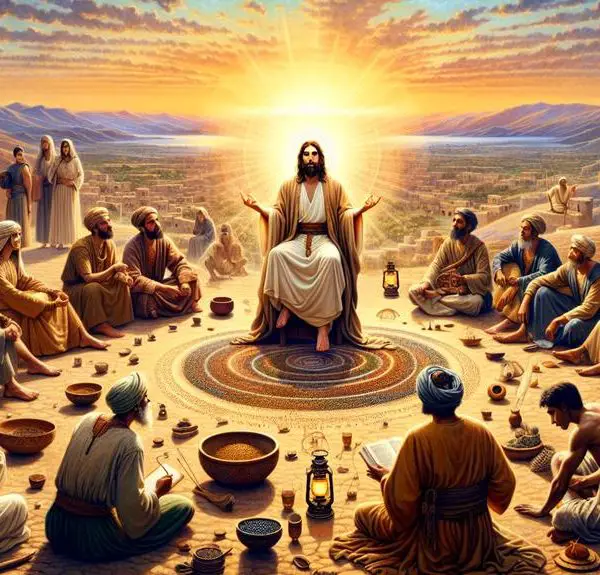
Sign up